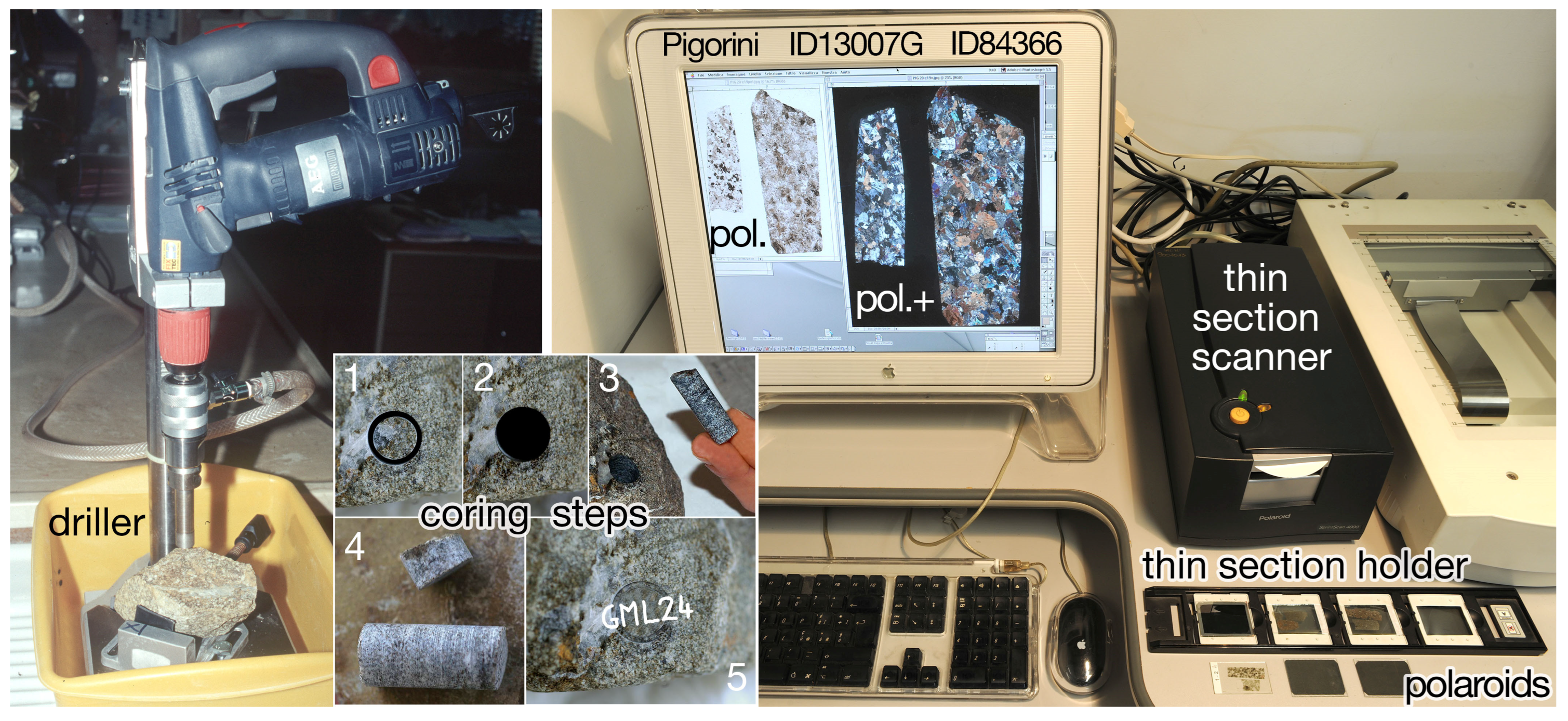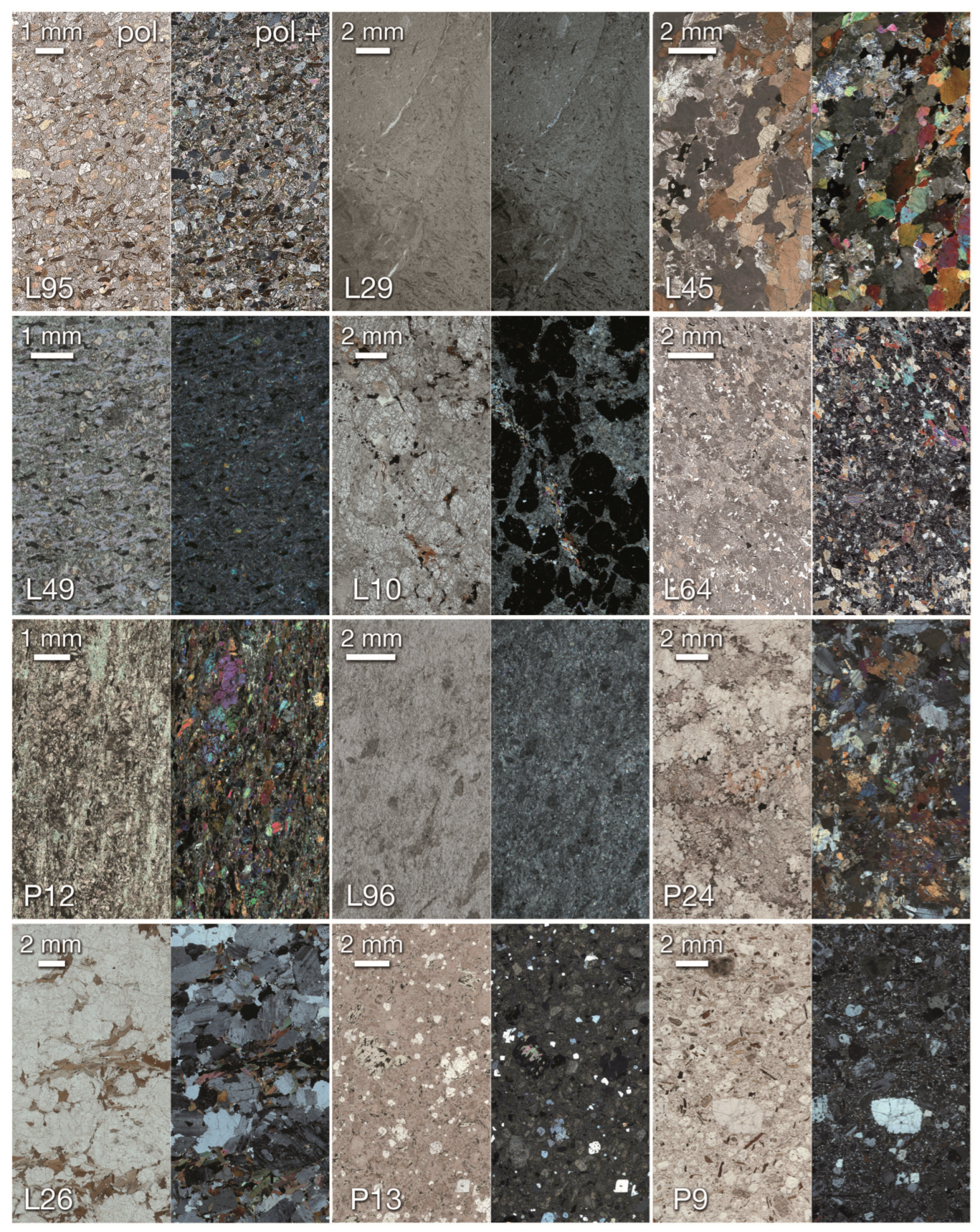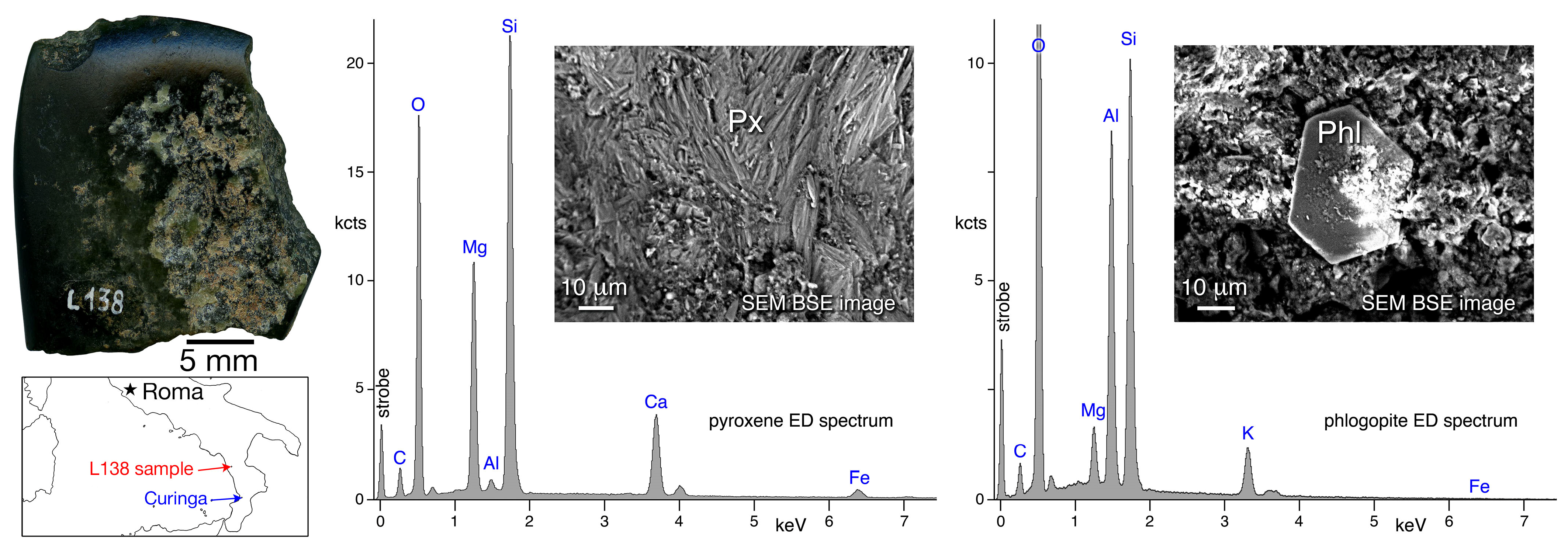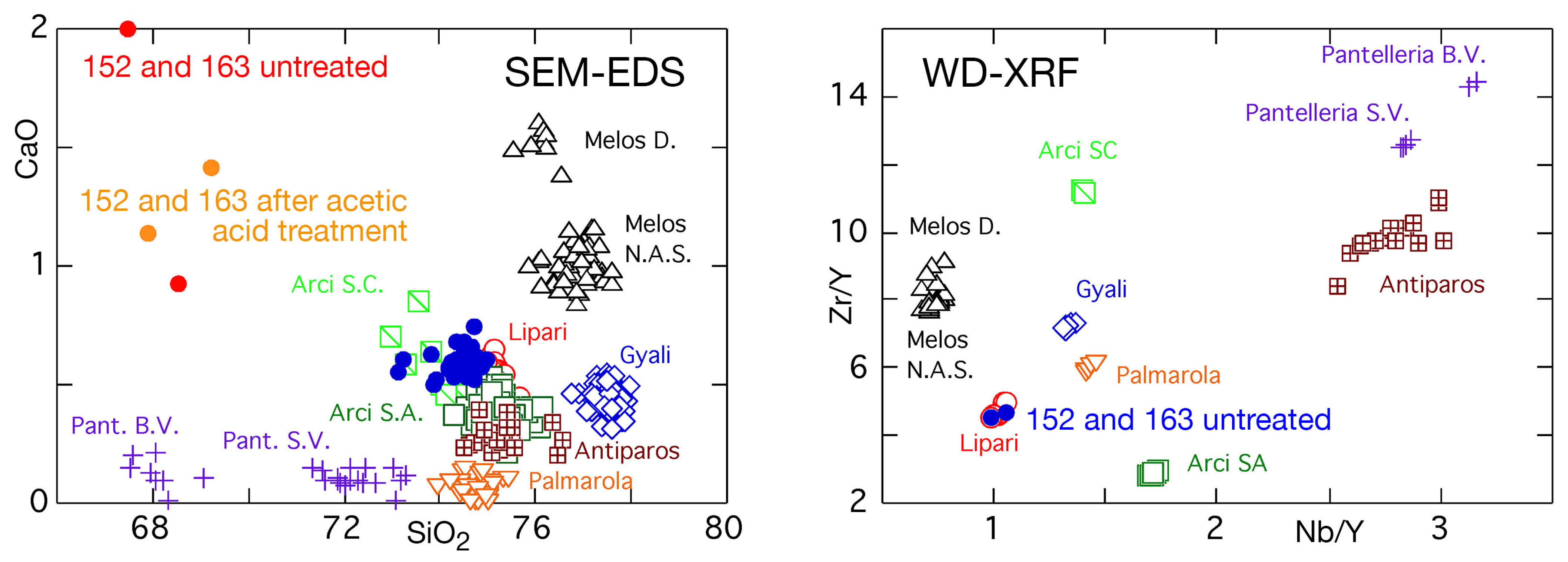Provenance of Neolithic Stone Artefacts through Minimally Invasive or Absolutely Non-Destructive Petroarchaeometric Investigations: Some Cases from Calabria (Southern Italy)
Abstract
1. Introduction
2. Materials and Methods
2.1. Sample Distribution and Their Geological Context
2.2. Petroarchaeometric Investigation Techniques
3. Results
3.1. Petrographic Features of Artefacts
3.2. Mineral Chemistry of Artefacts
3.3. Chemistry of Obsidians
4. Discussion
5. Conclusions
Supplementary Materials
Author Contributions
Funding
Data Availability Statement
Acknowledgments
Conflicts of Interest
References
- Acquafredda, P. XRF technique. In Chemical Analysis in Cultural Heritage; Sabbatini, L., van der Werf, I.D., Eds.; Physical Sciences Reviews [Online]; De Gruyter: Berlin, Germany, 2019; pp. 31–61. [Google Scholar]
- Aspinall, A.; Feather, S.; Renfrew, C. Neutron Activation Analysis of Aegean Obsidians. Nature 1972, 237, 333–334. [Google Scholar] [CrossRef]
- Nelson, D.E.; D’Auria, J.M.; Bennett, R.B. Characterization of Pacific Northwest coast obsidian by X-ray fluorescence analysis. Archaeometry 1975, 17, 85–97. [Google Scholar] [CrossRef]
- Gale, N.H. Mediterranean obsidian source characterization by strontium isotope analysis. Archaeometry 1981, 23, 41–51. [Google Scholar] [CrossRef]
- Kilikoglou, V.; Bassiakos, Y.; Doonan, R.C.; Stratis, J. NAA and ICP analysis of obsidian from Central Europe and the Aegean: Source characterisation and provenance determination. J. Radioanal. Nucl. Chem. 1997, 216, 87–93. [Google Scholar] [CrossRef]
- Gratuze, B.; Blet-Lemarquand, M.; Barrandon, J.N. Mass spectrometry with laser sampling: A new tool to characterize archaeological materials. J. Radioanal. Nucl. Chem. 2001, 26, 869–881. [Google Scholar]
- Tykot, R.H. Chemical fingerprinting and source tracing of obsidian: The central Mediterranean trade in black gold. Acc. Chem. Res. 2002, 35, 618–627. [Google Scholar] [CrossRef]
- De Francesco, A.M.; Crisci, G.M.; Bocci, M. Non-destructive analytic method using XRF for determination of provenance of archaeological obsidians from the Mediterranean area: A comparison with traditional XRF methods. Archaeometry 2008, 50, 337–350. [Google Scholar] [CrossRef]
- Phillips, S.C.; Speakman, R.J. Initial source evaluation of archaeological obsidian from the Kuril Islands of the Russian Far East using portable XRF. J. Archaeol. Sci. 2009, 36, 1256–1263. [Google Scholar] [CrossRef]
- Frahm, E.; Doonan, R.C.P.; Kilikoglou, V. Handheld portable X-ray fluorescence of Aegean obsidians. Archaeometry 2014, 56, 228–260. [Google Scholar] [CrossRef]
- Orange, M.; Le Bourdonnec, F.-X.; Scheffers, A.; Joannes-Boyau, R. Sourcing obsidian: A new optimized LA-ICP-MS protocol. STAR 2016, 2, 192–202. [Google Scholar] [CrossRef]
- Muntoni, I.M.; Micheletti, F.; Mongelli, N.; Pallara, M.; Acquafredda, P. First evidence in Italian mainland of Pantelleria obsidian: Highlights from WD-XRF and SEM-EDS characterization of Neolithic artefacts from Galliano necropolis (Taranto, Southern Italy). J. Archaeol. Sci. Rep. 2022, 45, 1–7. [Google Scholar] [CrossRef]
- Pons, J. Gandhāran art(s): Methodologies and preliminary results of a stylistic analysis. In The Geography of Gandhāran Art Proceedings of the Second International Workshop of the Gandhāra Connections Project; Rienjang, W., Stewart, P., Eds.; University of Oxford: Oxford, UK, 2019. [Google Scholar]
- Antonelli, F.; Lazzarini, L. Mediterranean trade of the most widespread Roman volcanic millstones from Italy and petrochemical markers of their raw materials. J. Archaeol. Sci. 2010, 37, 2081–2092. [Google Scholar] [CrossRef]
- Brandl, M.; Martinez, M.M.; Hauzenberger, C.; Filzmoser, P.; Nymoen, P.; Mehler, N. A multi-technique analytical approach to sourcing Scandinavian flint: Provenance of ballast flint from the shipwreck “Leirvigen 1”, Norway. PLoS ONE 2018, 13, 1–34. [Google Scholar] [CrossRef] [PubMed]
- Marinova, I.; Ivanova, P.; Tacheva, E.; Vitov, O. Mineral composition and rock provenance of a prehistoric stone axe head from the surroundings of Nevestino village, Kyustendil District, SW Bulgaria. Archaeol. Anthropol. Sci. 2019, 11, 2929–2936. [Google Scholar] [CrossRef]
- Jesse, F.; Hollerbach, R.; Schröder, A.; Wennrich, V. The signature of the stones: pXRF studies on prehistoric axes from the Eastern Sahara. J. Archaeol. Sci. Rep. 2023, 49, 104028. [Google Scholar] [CrossRef]
- Dilaria, S.; Bonetto, J.; Germinario, L.; Previato, C.; Girotto, C.; Mazzoli, C. The stone artifacts of the National Archaeological Museum of Adria (Rovigo, Italy): A noteworthy example of heterogeneity. Archaeol. Anthropol. Sci. 2024, 16, 14. [Google Scholar] [CrossRef]
- Paglionico, A.; Piccarreta, G. History and petrology of a fragment of the deep crust in the Serre (Calabria, Italy). Neues Jb. Miner. Petrogr. Mitt. Monat. 1978, 9, 385–396. [Google Scholar]
- Caggianelli, A.; Del Moro, A.; Paglionico, A.; Piccarreta, G.; Pinarelli, L.; Rottura, A. Lower crustal granite genesis connected with chemical fractionation in the continental crust of Calabria (Southern Italy). Eur. J. Miner. 1991, 3, 159–180. [Google Scholar] [CrossRef]
- Acquafredda, P.; Fornelli, A.; Piccarreta, G.; Pascazio, A. Multi-stage dehydration–decompression in the metagabbros from the lower crustal rocks of the Serre (southern Calabria, Italy). Geol. Mag. 2008, 145, 397–411. [Google Scholar] [CrossRef]
- Graessner, T.; Schenk, V. An exposed Hercynian deep crustal section in the Sila Massif of Northern Calabria: Mineral chemistry, petrology and a P-T path of granulite-facies metapelitic migmatites and metabasites. J. Petrol. 2001, 42, 931–961. [Google Scholar] [CrossRef]
- Caggianelli, A.; Prosser, G. Modelling the thermal perturbation of the continental crust after intraplating of thick granitoid sheets: A comparison with the crustal sections in Calabria (Italy). Geol. Mag. 2002, 139, 699–706. [Google Scholar] [CrossRef]
- Fornelli, A.; Festa, V.; Micheletti, F.; Spiess, R.; Tursi, F. Building an Orogen: Review of U-Pb Zircon Ages from the Calabria-Peloritani Terrane to Constrain the Timing of the Southern Variscan Belt. Minerals 2020, 10, 944. [Google Scholar] [CrossRef]
- Tursi, F.; Bianco, C.; Brogi, A.; Caggianelli, A.; Prosser, G.; Ruggieri, G.; Braschi, E. Cold subduction zone in northern Calabria (Italy) revealed by lawsonite-clinopyroxene blueschists. J. Metamorph. Geol. 2020, 38, 451–469. [Google Scholar] [CrossRef]
- Festa, V.; Caggianelli, A.; Langone, A.; Prosser, G. Time-space relationships among structural and metamorphic aureoles related to granite emplacement: A case study from the Serre Massif (southern Italy). Geol. Mag. 2013, 150, 441–454. [Google Scholar] [CrossRef]
- Breglia, F.; Caricola, I.; Larocca, F. Macrolithic tools for mining and primary processing of metal ores from the site of Grotta della Monaca (Calabria, Italy). J. Lithic Stud. 2016, 3, 57–76. [Google Scholar] [CrossRef]
- Larocca, F.; Breglia, F. Grooved stone tools from Calabria region (Italy): Archaeological evidence and research perspectives. J. Lithic Stud. 2016, 3, 301–312. [Google Scholar] [CrossRef]
- Acquafredda, P.; Larocca, F.; Minelli, A.; Micheletti, F.; Pallara, M. Petroarcheometric analysis on obsidian artefacts found within some Neolithic–Eneolithic period caves of Southern Italy. Open Archaeol. 2020, 6, 107–123. [Google Scholar] [CrossRef]
- Larocca, F. (Ed.) La Miniera Pre-Protostorica di Grotta Della Monaca (Sant’Agata di Esaro—Cosenza); Centro Regionale di Speleologia “Enzo dei Medici”, Roseto Capo Spulico, Pubblicità & Stampa: Bari, Italy, 2005. [Google Scholar]
- Bonardi, G.; Colonna, V.; Dietrich, D.; Giunta, G.; Liguori, V.; Lorenzoni, S.; Paglionico, A.; Perrone, V.; Piccarreta, G.; Russo, M.; et al. L’Arco Calabro Peloritano: Carta geologica. Allegato a: L’Arco Calabro-Peloritano nell’Orogene Appenninico-Maghrebide. Mem. Soc. Geol. It. 1976, 17. [Google Scholar]
- Lorenzoni, S.; Orsi, G.; Zanettin Lorenzoni, E. Metallogenesis in the tectonic units and lithogenetic environments of Calabria (Southern Italy). Mem. Sci. Geol. 1982, 35, 411–428. [Google Scholar]
- Bonardi, G.; Cavazza, W.; Perrone, V.; Rossi, S. Calabria-Peloritani Terrane and northern Ionian Sea. In Anatomy of an Orogen: The Apennines and Adjacent Mediterranean Basins; Vai, G.B., Martini, I.P., Eds.; Springer: Dordrecht, The Netherlands, 2001; pp. 287–306. [Google Scholar]
- Amodio Morelli, L.; Bonardi, G.; Colonna, V.; Dietrich, D.; Giunta, G.; Ippolito, F.; Liguori, V.; Lorenzoni, S.; Paglionico, A.; Perrone, V.; et al. L’arco calabro peloritano nell’orogene appenninico-magrebide. Mem. Soc. Geol. It. 1976, 17, 1–60. [Google Scholar]
- Cirrincione, R.; Fazio, E.; Fiannacca, P.; Ortolano, G.; Pezzino, A.; Punturo, R. The Calabria-Peloritani Orogen, a composite terrane in Central Mediterranean; its overall architecture and geodynamic significance for a pre-Alpine scenario around the Tethyan basin. Period. Mineral. 2015, 84, 701–749. [Google Scholar]
- Bigazzi, G.; Oddone, M.; Radi, G. The Italian obsidian sources. Archeometriai Műhely 2005, 1, 1–13. [Google Scholar]
- Tykot, R.H.; Iovino, M.R.; Martinelli, M.C.; Beyer, L. Ossidiana da Lipari: Le fonti, la distribuzione, la tipologia e le tracce d’usura. In Atti del XXXIX Riunione Scientifica dell’Istituto Italiano di Preistoria e Protostoria: Materie Prime e Scambi nella Preistoria Italiana; Istituto Italiano di Preistoria e Protostoria: Firenze, Italy, 2006; pp. 592–597. [Google Scholar]
- Lucchi, F. Stratigraphic methodology for the geological mapping of volcanic areas: Insights from the Aeolian archipelago (southern Italy). In The Aeolian Islands Volcanoes; Lucchi, F., Peccerillo, A., Keller, J., Tranne, C.A., Rossi, P.L., Eds.; The Geological Society of London: London, UK, 2013; pp. 37–53. [Google Scholar]
- Albert, P.G.; Tomlinson, E.L.; Christina Smith, V.; Di Traglia, F.; Pistolesi, M.; Morris, A.; Donato, P.; De Rosa, R.; Sulpizio, R.; Keller, J.; et al. Volcanic glass geochemistry of pyroclastic deposits for the last 50ka in the Aeolian Islands: A proximal database for distal tephrochronology. J. Volcanol. Geotherm. Res. 2017, 336, 81–107. [Google Scholar] [CrossRef]
- Tykot, R.H. Obsidian studies in the Prehistoric Central Mediterranean: After 50 years, what have we learned and what still needs to be done? Open Archaeol. 2017, 3, 264–278. [Google Scholar] [CrossRef]
- Freund, K.P. A long-term perspective on the exploitation of Lipari obsidian in central Mediterranean prehistory. Quart. Int. 2018, 468, 109–120. [Google Scholar] [CrossRef]
- Martinelli, M.C.; Coltelli, M.; Manni, M.; Bonizzoni, L.; Guglielmetti, A.; Oddone, M.; Balestrieri, M.L. Prehistorical Obsidian Sources in the Island of Lipari (Aeolian Islands). Open Archaeol. 2020, 6, 393–402. [Google Scholar] [CrossRef]
- Pouchou, J.L.; Pichoir, F. A simplified version of the “PAP” model for matrix corrections in EPMA. In Microbeam Analysis; Newbury, D.E., Ed.; San Francisco Press: San Francisco, CA, USA, 1988; pp. 315–318. [Google Scholar]
- Pouchou, J.L.; Pichoir, F. Quantitative analysis of homogeneous or stratified microvolumes applying the model “PAP”. In Electron Probe Quantitation; Heinrich, K.F.J., Newbury, D.E., Eds.; Plenum Press: New York, NY, USA, 1991; pp. 31–75. [Google Scholar]
- Coombs, D.S.; Nakamura, Y.; Vuagnat, M. Pumpellyite-actinolite facies schists of the Taveyanne Formation, near Loeche, Valais, Switzerland. J. Petrol. 1976, 17, 440–471. [Google Scholar] [CrossRef]
- Acquafredda, P.; Muntoni, I.M.; Pallara, M. Reassessment of WD-XRF method for obsidian provenance shareable databases. Quart. Int. 2018, 468, 169–178. [Google Scholar] [CrossRef]
- Whitney, D.L.; Evans, B.W. Abbreviations for names of rock-forming minerals. Am. Mineral. 2010, 95, 185–187. [Google Scholar] [CrossRef]
- Cortesogno, L.; Lucchetti, G.; Spadea, P. Pumpellyite in low-grade metamorphic rocks from Ligurian and Lucanian Apennines, Maritime Alps and Calabria (Italy). Contrib. Miner. Petrol. 1984, 85, 14–24. [Google Scholar] [CrossRef]
- Rizzo, G.; Piluso, E.; Morten, L. Phlogopite from the Serre ultramafic rocks Central Calabria, Southern Italy. Eur. J. Miner. 2001, 13, 1139–1151. [Google Scholar] [CrossRef]
- Zanetti, A.; Mazzucchelli, M.; Rivalenti, G.; Vannucci, R. The Finero phlogopite-peridotite massif: An example of subduction-related metasomatism. Contrib. Miner. Petrol. 1999, 134, 107–122. [Google Scholar] [CrossRef]









| Metamorphic rocks | ||||
| Name | Protoliths | Mineralogical association | Metamorphic grade | Provenance of sample |
| Metagabbro | Igneous | Pl, Cpx, Opx, Amph, Grt, Bt | High grade | Grotta della Monaca |
| Mafic granulite | Igneous | Pl, Opx, Kfs, Cpx, Qtz, Amph, Grt | High grade | Grotta della Monaca |
| Felsic granulite | Igneous/sedimentary | Qtz, Pl, Kfs, Opx/Sil, Grt | High grade | Grotta della Monaca |
| Meta-ultramafite | Igneous | Ol, Px, Pl, Amph, Phl, Spl, Srp, Opq | Low grade | Grotta della Monaca |
| Amphibolite and amphibole-bearing gneiss | Igneous/sedimentary | Amph, Bt, Pl, Qtz | High/medium grade | Grotta della Monaca/ Museo Pigorini |
| Garnet-biotite-sillimanite gneiss | Sedimentary | Qtz, Pl, Kfs, Bt, Sil, Grt, Crd | High grade | Grotta della Monaca/ Museo Pigorini |
| Glaucophane- lawsonite- pumpellyite- prehnite- schists | Igneous | Gln- Lws- Pmp- Prh, Ep, Qtz, Pl, Chl | Low grade(HP-LT) | Grotta della Monaca |
| Actinolite schist | Igneous/sedimentary | Amph, Chl, Qtz, Pl, Ep, Px, Opq | Low grade | Museo Pigorini |
| Metarenite | Sedimentary | Qtz, Pl, Kfs, Grt, Amph, Chl, Ep, Cal | Low grade | Museo Pigorini |
| Marble | Sedimentary | Cal, ± Qtz | Low grade | Grotta della Monaca |
| Sedimentary rocks | ||||
| Name | Mineralogical composition/fossils | Provenance of sample | ||
| Litharenites | Lithic label fragments, Qtz, Fsp, Mca, fossils | Grotta della Monaca | ||
| Hybrid sandstone | Cal, Qtz, Mca, Fsp, fossils | Grotta della Monaca | ||
| Quartzarenites | Qtz, Kfs | Grotta della Monaca | ||
| Limestones and marl-limestone | Cal, fossils | Grotta della Monaca | ||
| Dolomites | Dol, fossils | Grotta della Monaca | ||
| Magmatic rocks | ||||
| Name | Mineralogical composition | Type | Texture | Provenance of sample |
| Gabbro-diorite | Pl, Px, Amph | Intrusive | Holocrystalline | Grotta della Monaca /Museo Pigorini |
| Granite | Qtz, Pl, Kfs, Bt | Intrusive | Holocrystalline | Grotta della Monaca /Museo Pigorini |
| Tonalite | Qtz, Pl, Bt, Amph | Intrusive | Holocrystalline | Grotta della Monaca |
| Rhyolite | Qtz, Fsp, Bt | Effusive | Porphyritic | Museo Pigorini |
| Dacite | Qtz, Pl, Bt | Effusive | Porphyritic | Museo Pigorini |
Disclaimer/Publisher’s Note: The statements, opinions and data contained in all publications are solely those of the individual author(s) and contributor(s) and not of MDPI and/or the editor(s). MDPI and/or the editor(s) disclaim responsibility for any injury to people or property resulting from any ideas, methods, instructions or products referred to in the content. |
© 2024 by the authors. Licensee MDPI, Basel, Switzerland. This article is an open access article distributed under the terms and conditions of the Creative Commons Attribution (CC BY) license (https://creativecommons.org/licenses/by/4.0/).
Share and Cite
Acquafredda, P.; Festa, V.; Micheletti, F.; Fornelli, A. Provenance of Neolithic Stone Artefacts through Minimally Invasive or Absolutely Non-Destructive Petroarchaeometric Investigations: Some Cases from Calabria (Southern Italy). Heritage 2024, 7, 621-637. https://doi.org/10.3390/heritage7020030
Acquafredda P, Festa V, Micheletti F, Fornelli A. Provenance of Neolithic Stone Artefacts through Minimally Invasive or Absolutely Non-Destructive Petroarchaeometric Investigations: Some Cases from Calabria (Southern Italy). Heritage. 2024; 7(2):621-637. https://doi.org/10.3390/heritage7020030
Chicago/Turabian StyleAcquafredda, Pasquale, Vincenzo Festa, Francesca Micheletti, and Annamaria Fornelli. 2024. "Provenance of Neolithic Stone Artefacts through Minimally Invasive or Absolutely Non-Destructive Petroarchaeometric Investigations: Some Cases from Calabria (Southern Italy)" Heritage 7, no. 2: 621-637. https://doi.org/10.3390/heritage7020030
APA StyleAcquafredda, P., Festa, V., Micheletti, F., & Fornelli, A. (2024). Provenance of Neolithic Stone Artefacts through Minimally Invasive or Absolutely Non-Destructive Petroarchaeometric Investigations: Some Cases from Calabria (Southern Italy). Heritage, 7(2), 621-637. https://doi.org/10.3390/heritage7020030





